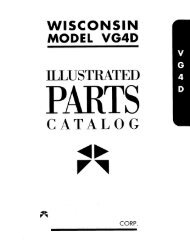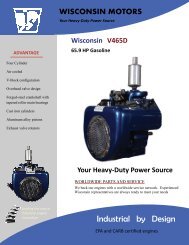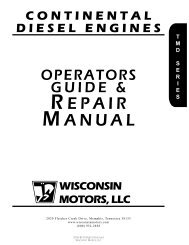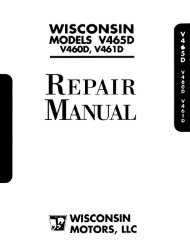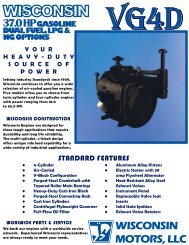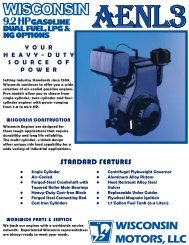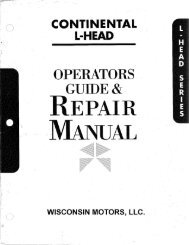WISCONSIN MODEL VG4D - Wisconsin Motors
WISCONSIN MODEL VG4D - Wisconsin Motors
WISCONSIN MODEL VG4D - Wisconsin Motors
Create successful ePaper yourself
Turn your PDF publications into a flip-book with our unique Google optimized e-Paper software.
CENTERLINE MARK<br />
OF No. 1 CYLINDER<br />
ED<br />
~NE<br />
/HEEL<br />
RUNNING SPARK<br />
ADVANCE TIMING<br />
HOLE FOR CHECKING<br />
WITH NEON LIGHT<br />
TURN CLOCKWISE<br />
AS INDICATED<br />
BY ARF<br />
)ISTRIBUTOR<br />
R~OR<br />
BREAKER P~D~ INTS<br />
JUST BERING TO<br />
DIS’<br />
Fig. 13<br />
Fig. 14<br />
NOTCH IN DISTRIBU1<br />
%),’ith the advance arm clamp screw loose, turn the<br />
distributor body slightly in a counter-clockwise rotation<br />
so that the breaker points are firmly closed.<br />
Then turn the distributor body in a clockwise rotation<br />
until the breaker points are just beginning to open,<br />
See Fig. /~, At this point a slight resistance can be<br />
felt as the breaker point cam strikes the breaker point<br />
arm. Tighten advance arm clamp screw. The No. 1<br />
cylinder is now ready to fire in the retarded position,<br />
with the centerline of the distributor rotor in line with<br />
the center of the notch in the distributor body as<br />
shown in Fig. 14.<br />
The breaker point gap should be .018 to .022 inches.<br />
This opening should be checked before the distributor<br />
body is set, otherwise any adjustment made to<br />
the breaker point opening will change the ignition<br />
advance. Replace distributor dust cover. If care is<br />
exercised in the above operations, the spark timing<br />
should be accurate enough for satisfactory operation,<br />
however, checking spark advance with a neon lamp,<br />
as described in ’,~eon Lamp Timing’ is recommended.<br />
The four ignition cables from the distributor should<br />
be connected to the proper spark plugs. The cylinder<br />
shroud covers are marked for identification. The No.<br />
Fig. 15<br />
i terminal tower on the distributor is in line with the<br />
notch in the distributor body, Terminal sequence is<br />
1-3-4-2 in a counter-clockwise rotation. See Fig. 15.<br />
NEON LAMP TIMING<br />
The engine should be timed to the 23 ° advanced position<br />
at not less than 2000 R.P.M. Check timing with<br />
a neon lamp connected in series with No. 1 spark<br />
plug. Chalk or paint the end of the ’X’ marked vane<br />
on the flywheel, white. Then with the engine operating<br />
at 2000 R.P.M. or over, allow the flash from the<br />
neon lamp to illuminate the whitened vane. At the<br />
time of the flash, the leading edge of the vane should<br />
line up with the running spark advance timing hole on<br />
the flywheel shroud, sec Fig. 1~. If it does not, the<br />
advance arm clamp screw should be loosened as<br />
shown in Fig. 1 l, and the distributor body turned<br />
slightly clockwise or counter-clockwise, as required,<br />
until the white flywhee/ vane matches up with the<br />
advance timing hole. Be sure advance arm clamp<br />
is then carefully tightened. If the engine is running<br />
below 2000 R.P.M. when timing, the automatic advance<br />
in the distributor will not be fully advanced<br />
and damages to the engine may result when the engine<br />
is operated at higher speeds. Mount flywheel<br />
screen if removed. For convenience, a 3/8" dia. hole<br />
was added to screen rim to check timing without removing<br />
screen.<br />
DISTRIBUTOR<br />
AND GENERATOR MAINTENANCE<br />
The distributor breaker point gap should be .018 to<br />
.022 inches. To readjust breaker point gap, turn engine<br />
over by means of the starting crank until the<br />
distributor breaker arm rubbing block is on a high<br />
point of the cam. Loosen the stationary contact lock.<br />
nut and screw fixed contact, in or out, until correct<br />
gap is obtained. Tighten locknut and recheck gap.<br />
The generator and distributor should be periodically<br />
lubricated and inspected for external conditions<br />
which would affect their operation.<br />
It is recommended that the generator oiler, located<br />
below the primary terminal of the distributor, be given<br />
14




